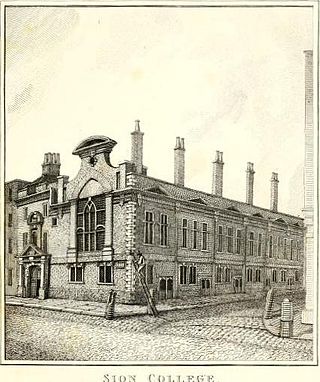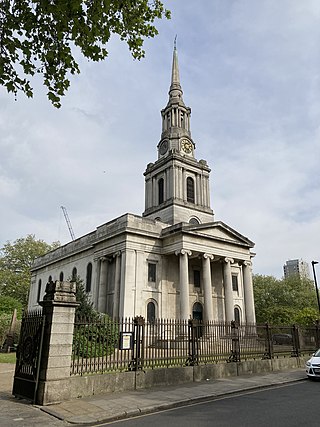
Stepney is an area in London, England and is located in the London Borough of Tower Hamlets. It is in East London and part of the East End. Stepney is no longer officially defined, and is usually used to refer to a relatively small area. However, for much of its history the place name applied to a much larger manor and parish. Stepney Green is a remnant of a larger area of Common Land formerly known as Mile End Green.

Whitechapel is an area in London, England, and is located in the London Borough of Tower Hamlets. It is in East London and part of the East End. It is the location of Tower Hamlets Town Hall and therefore the borough town centre. Whitechapel is located 3.4 miles (5.5 km) east of Charing Cross.

St Dunstan's, Stepney, is an Anglican church which stands on a site that has been used for Christian worship for over a thousand years. It is located in Stepney High Street, in Stepney, London Borough of Tower Hamlets.

Bromley, commonly known as Bromley-by-Bow, is a district in the London Borough of Tower Hamlets in East London, located on the western banks of the River Lea, in the Lower Lea Valley in East London.

Mile End is an area in London, England and is located in the London Borough of Tower Hamlets. It is in East London and part of the East End. It is 4.2 miles (6.8 km) east of Charing Cross. Situated on the part of the London-to-Colchester road called Mile End Road, it was one of the earliest suburbs of London.

Bow is an area of east London, England, within the London Borough of Tower Hamlets, 4.6 miles (7.4 km) east of Charing Cross.

St Mary's Church, Barnes, is the parish church of Barnes, formerly in Surrey and now in the London Borough of Richmond upon Thames. It is a Grade II* listed building.

Sion College, in London, is an institution founded by royal charter in 1630 as a college, guild of parochial clergy and almshouse, under the 1623 will of Thomas White, vicar of St Dunstan's in the West.

St Paul's Church, Shadwell, is a Grade II* listed Church of England church, located between The Highway and Shadwell Basin, on the edge of Wapping, in the East End of London, England. The church has had varying fortunes over many centuries, and is now very active, having been supported recently by Holy Trinity Brompton Church.

Old Ford is an area in the London Borough of Tower Hamlets that is named after the natural ford which provided a crossing of the River Lea.

All Saints Church, Poplar, is a church in Newby Place, Poplar, London Borough of Tower Hamlets, and is the Church of England parish church of Poplar. It was built in 1821–3 to serve the newly created parish.

St John at Hackney is a Grade II* listed Anglican Church in the heart of the London Borough of Hackney with a large capacity of around 2,000. It was built in 1792 to replace Hackney's medieval parish church, of which St Augustine's Tower remains, at the edge of its churchyard. The church faces north towards Clapton Square, with the nearby Sutton House and Hackney Central station also accessible from the churchyard to the east and south, respectively. As well as a thriving parish church, St John at Hackney has also become known as a notable music venue, playing host to the likes of Coldplay, Ed Sheeran, Emeli Sande, Robbie Williams, Griff and Interpol.

Christopher Thomas James Chessun is a British Anglican bishop. Since 2011, he has been Bishop of Southwark in the Church of England.

St Mary Matfelon church, popularly known as St Mary's, Whitechapel, was a Catholic then after the English Reformation a Church of England parish church on Whitechapel Road, Whitechapel, London. It is repeatedly supposed by many works and oral histories that the church was covered in a lime whitewash, which gave the chapelry (district) its common name, Whitechapel. Around 1320, it became called St Mary Matfelon. About that time it became a parish in its own right but its priest for many years was a nominee of the Rector of Stepney. The church's earliest known priest was Hugh de Fulbourne in 1329. Last rebuilt in the 19th century, the church was firebombed during the Blitz leading to its demolition in 1952. Its nave's stone footprint and graveyard – its headstones removed – are the basis of Altab Ali Park on the south side of the thoroughfare.
Edward Bowles Knottesford-Fortescue (1816–1877) was an English Anglican priest who converted to Catholicism.

The Stratford Martyrs were eleven men and two women who were burned at the stake together for their Protestant beliefs, either at Stratford-le-Bow, Middlesex or Stratford, Essex, both near London, on 27 June 1556 during the Marian persecutions.

St Mary the Virgin, Mortlake, is a parish church in Mortlake, in the London Borough of Richmond upon Thames. It is part of the Church of England and the Anglican Communion. The rector is The Revd Canon Dr Ann Nickson.

St Mary's Church, Bow was a Church of England parish church in Bromley St Leonard's in east London. 'Bromley St Leonard's' was split from the parish of Stepney in 1536, reusing the priory church from the recently dissolved St Leonard's Priory, a Benedictine nunnery. It contained significant monumental sculpture.
Ralph Cawley was an English clergyman and Oxford academic.
The Metropolitan Public Gardens Association is a charity in London for the purposes of the preservation of public parks and gardens, established in 1882. It facilitated the creation of new public open spaces, including from philanthropic landowners within its membership. The MPGA was involved in the formation and development of other amenity organisations. The charity still exists; in recent decades its emphasis has changed to smaller parcels of land and smaller projects within larger spaces, as well as to themed projects. The MPGA was the starting point for the careers of the ground-breaking female landscape gardeners Fanny Wilkinson and Madeline Agar.




















